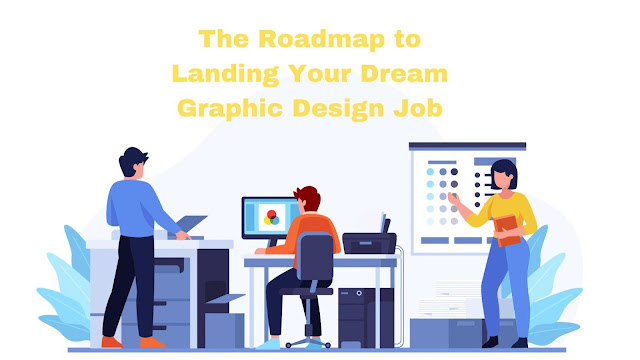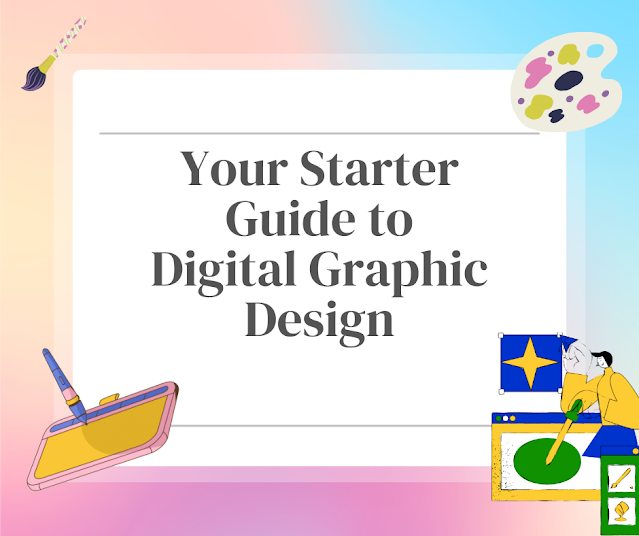The Roadmap to Landing Your Dream Graphic Design Job
When you think about graphic design, what comes to mind? Perhaps it's a beautifully crafted logo, an eye-catching website, or a captivating advertisement. Graphic design is a dynamic and creative field that plays a pivotal role in shaping how we perceive the world around us. It combines artistry, technology, and communication to convey messages, evoke emotions, and leave lasting impressions.
In this blog, you will embark on a journey that explores the path to a fulfilling and successful career in graphic design. Whether you're a student aspiring to enter the field, a self-taught designer looking to go pro, or someone seeking a career change, this roadmap is designed to guide you every step of the way. You can take graphic design course in Delhi to get hands-on experience in this field.
Why Pursue a Career in Graphic Design?
Before we dive into the nitty-gritty details of building your graphic design career, let's first explore why this profession is worth pursuing. Graphic design offers a unique blend of creativity, innovation, and practicality. Some compelling reasons why you might consider a career in this field:
Creative Expression: Graphic designers have the opportunity to unleash their creativity and artistic talents daily. They transform ideas into visual concepts that can captivate, inspire, and inform.
Influence and Impact: Graphic design plays a critical role in shaping brands, products, and messages. Designers have the power to influence consumer choices and communicate important ideas.
Versatility: Graphic design is a versatile field that spans industries, from advertising and marketing to web design, print media, and even film. You can find your niche and explore various design specialties.
Constant Evolution: The world of design is ever-changing, driven by technology and cultural shifts. This dynamic nature keeps the profession exciting and offers opportunities for continuous learning and growth.
High Demand: In our visually-driven society, the demand for skilled graphic designers remains strong. Companies, organizations, and individuals all need design expertise.
Self-Discovery and Skill Assessment
Identifying Your Passion and Interests in Design
Exploring Your Creative Passions: Reflect on what aspects of design ignite your creativity. Is it logo design, typography, web design, or illustration? Identifying your passions will help you focus your efforts and find fulfillment in your work.
Inspirationfrom Others: Study the work of renowned designers and artists. Are there specific styles, movements, or designers that resonate with you? Understanding what inspires you can shape your design journey.
Personal Projects: Experiment with personal design projects. Create pieces purely for self-expression and exploration. These projects can reveal your genuine interests and strengths.
Identifying Skill Gaps and Areas of Improvement
Gap Analysis: Compare your skills and interests to the industry's demands. Where do you see gaps or misalignments? For instance, if you're interested in UI/UX design but lack experience, that's an area to address.
Industry Trends: Research current design trends and emerging technologies. Are there new skills you should acquire to stay competitive in the field?
Peer and Mentor Feedback: Seek feedback from peers, mentors, or experienced designers you respect. They can provide valuable insights into areas where you can improve.
Mastering Design Software and Tools
As a graphic designer, proficiency with design software and tools is essential for creating stunning and effective visual content. In this chapter, we will explore the essential graphic design software and tools you need to master and provide tips for improving your efficiency and effectiveness in using them.
Essential Graphic Design Software and Tools
Adobe Creative Cloud: An industry standard, Adobe's suite includes Photoshop (for image editing), Illustrator (for vector graphics), InDesign (for layout design), and more. Familiarity with these tools is often a requirement for graphic design jobs.
Sketch: Popular among UI/UX designers, Sketch is known for its user interface and web design capabilities. It offers a range of plugins for enhanced functionality.
Figma: Figma is a collaborative design tool that's especially valuable for remote teams. It allows real-time collaboration and prototyping.
CorelDRAW: An alternative to Adobe Illustrator, CorelDRAW is favored by some designers for its vector illustration capabilities.
Procreate: Ideal for digital illustrators and artists, Procreate is a powerful app for creating digital art on tablets.
Typography Tools: Familiarize yourself with font management tools like FontBase and Typewolf to enhance your typography skills.
Tips for Proficiency and Efficiency
Tutorials and Courses: Take advantage of online tutorials and courses to learn software features and techniques. Platforms like Udemy, Lynda (now LinkedIn Learning), and Coursera offer a wide range of design courses.
Keyboard Shortcuts: Learn keyboard shortcuts for your chosen software. They can significantly speed up your workflow. Adobe software, for example, has extensive keyboard shortcuts for various functions.
Practice Regularly: The more you practice, the more proficient you become. Work on personal projects, recreate designs you admire, and challenge yourself with new projects regularly.
Stay Updated: Software updates often introduce new features and improvements. Stay updated with the latest versions and explore what's new.
Join Design Communities: Participate in design forums and communities like Behance, Dribbble, or Adobe's Community forums. You can learn from others, seek feedback, and share your work.
Customize Your Workspace: Tailor your software's workspace to your preferences. Create custom workspaces with the tools and panels you use most frequently.
Version Control: If you work in teams or on long-term projects, use version control tools like Adobe Creative Cloud Libraries or GitHub to keep track of design iterations and changes.
Practice Efficient File Management: Organize your files and assets in a structured manner. Use consistent naming conventions and folder structures to avoid confusion.
Feedback and Critiques: Seek feedback on your work from peers, mentors, or online design communities. Constructive criticism can help you refine your skills.
Mastering design software and tools is an ongoing process. It requires dedication and continuous learning to keep up with the ever-evolving field of graphic design. By staying informed and practicing regularly, you can become proficient and efficient in using these essential tools to bring your creative visions to life.
Job Search Strategies for Graphic Designers
Crafting a Targeted Resume: Tailor your resume to each job application. Highlight relevant skills and experiences that align with the specific position you're applying for.
Online Job Portals: Utilize job search platforms like LinkedIn, Indeed, and Glassdoor to find graphic design job openings. Set up job alerts to stay updated on new listings.
Company Websites: Explore the websites of companies you admire and check their careers or jobs page for openings. Many organizations post job listings directly on their websites.
Networking: Leverage your professional network. Inform friends, colleagues, mentors, and fellow designers about your job search. Personal referrals can be highly valuable.
Freelancing Platforms: If you're open to freelance work, platforms like Upwork, Freelancer, and Fiverr can connect you with potential clients and projects.
Portfolio Websites: Maintain an online portfolio on platforms like Behance, Dribbble, or your personal website. Make it easy for potential employers to see your work.
Attend Industry Events: Participate in design conferences, meetups, and networking events. You might make connections that lead to job opportunities.
Preparing for Graphic Design Job Interviews:
Research the Company: Learn about the company's culture, values, and recent projects. Show that you're genuinely interested in working there
.
Review Your Portfolio: Be ready to discuss the projects in your portfolio in detail. Understand the design choices you made and the problem-solving process.
Dress Professionally: Dress appropriately for the interview, reflecting the company's dress code or industry norms.
Common Interview Questions and How to Answer Them:
"Tell me about yourself": Craft a concise and engaging response that highlights your design background, skills, and passion for design.
"What is your design process?": Explain how you approach a design project from concept to completion, emphasizing collaboration and creativity.
"Can you describe a challenging project and how you overcame it?": Share a real-life example, showcasing your problem-solving abilities and resilience.
"How do you handle feedback and criticism?": Demonstrate your ability to accept feedback gracefully and use it to improve your work.
Portfolio Presentations and Demonstrating Your Skills:
Start with a Strong Opener: Begin your portfolio presentation with a captivating project that showcases your best work.
Explain Your Process: Walk through your design process for each project, emphasizing how you solved specific design challenges.
Highlight Results: If possible, discuss the impact of your work, such as increased engagement, conversions, or brand recognition.
Be Open to Questions: Encourage interviewers to ask questions about your projects. Be prepared to provide additional details or insights.
By following these strategies and preparing thoroughly for interviews, you'll increase your chances of landing your dream graphic design job. Remember that each interview is an opportunity to not only showcase your skills but also to demonstrate your passion for design and your ability to contribute to the success of the organization.
Conclusion:
In your graphic design journey, you've armed yourself with skills, honed your craft, and navigated the job market. Now, as you step into interviews with confidence and a standout portfolio, your dream graphic design job is within reach. Remember, your unique creativity and dedication are your greatest assets. Embrace each opportunity with enthusiasm, and you'll find your place in the dynamic world of graphic design. Best wishes for a rewarding career ahead!






Comments
Post a Comment